Annex 1
A Troubleshooting
In hydraulic systems, a multitude of different errors can occur. The first step is to describe the error more precisely. (Trouble-shooting tree by using "General operating instructions 0/1" according to Bosch, version 1.0)
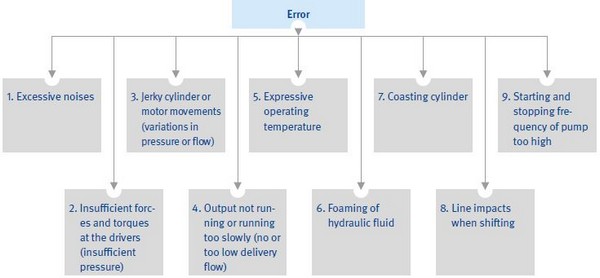
When the nature of the fault has been determined, the individual components are subject to a closer examination.
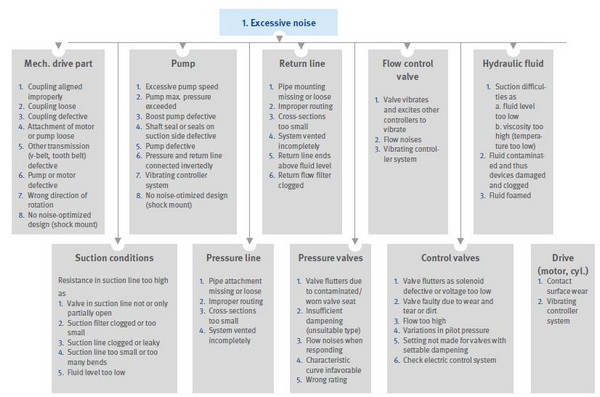
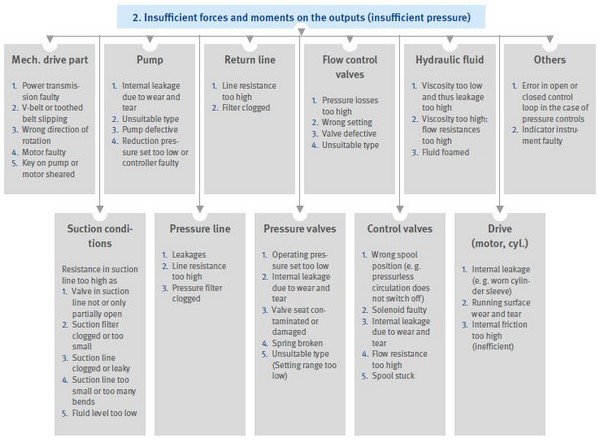
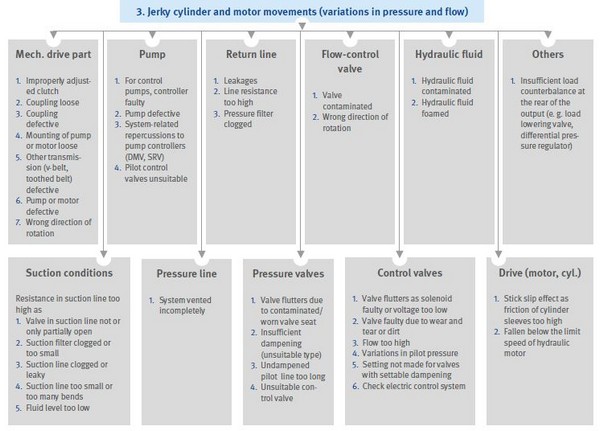
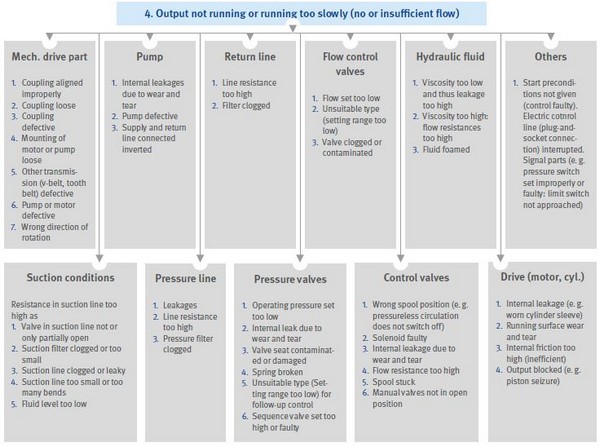
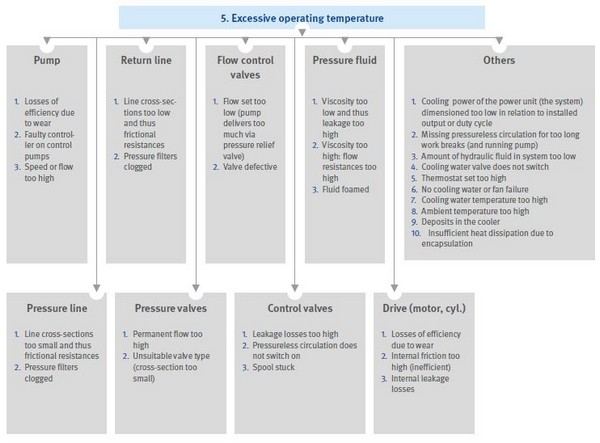


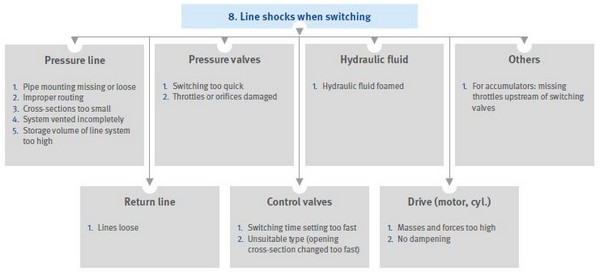

B Notices on maintenance
(on the basis of the "General operating instructions 0/1" according to BOSCH, version 1.0, pages 63ff.)
The safety notices listed in the following have to be observed at all times and carefully.
Conduct all maintenance works in due time, properly, and completely.
All employees have to be informed before starting any maintenance works.
The maintenance area has to be secured in a wide-ranging manner before starting any works.
Corresponding signs have to inform about maintenance works.
Signposts have to be attached to the control cabinet, the circuit breaker, actuators, and access in particular.
If the hydraulic assembly has to be switched off, it has to be secured against unintended re-closing by the following measures:
All drives have to be switched off and the hydraulic system has to be disconnected from the mains using the circuit breaker.
The pressure of the hydraulic assembly or component has to be reduced.
Possibly existing accumulators have to be depressurized.
The circuit breaker has to be secured against unscheduled re-closing.
Prior to every manual intervention on the hydraulic component:
All required details on depressurization and on the hydraulic components that are not depressurized automatically can be found in the corresponding operating instructions.
Cylinders have to be moved to the safe stop position.
All loads have to be lowered.
All pumps have to be turned off.
All vertical cylinders have to be supported mechanically against lowering. Maintenance works on lifted units must not be conducted without securing the units externally.
Existing accumulators have to be depressurized properly.
The pressure supply has to be switched off and the hydraulic assembly has to be secured against unscheduled re-closing.
It has to be ensured that only authorized personnel stay in the work area.
The required personal protection equipment has to be used.
The sections of the system and pressure lines to be opened have to cool down before starting any maintenance works.
Pressurized segments have to be opened slowly.
Due to check valves in the pressure lines above the pumps, the hydraulic system may still be under pressure after disconnecting it from the proper pressure supply. Some segments, e. g. servo cylinders, still remain pressurized due to the locked position of the proportional valves (the hydraulic scheme contains all valves in basic position).
Only new and tested components and spare parts identical in construction and lubricants in OEM quality are admissible for replacement/use. Installing used and untested components is strictly forbidden due to safety reasons.
During maintenance works which possibly require the removal of certain safeguarding equipment, machine movements must only be carried out with the utmost care. The safeguarding equipment has to be re-installed and tested for functionality before every commissioning procedure.
Welding, burning, or grinding works on the hydraulic aggregate or its superstructures must only be conducted upon approval of the local safety official and using appropriate protective covers against contaminations.
When conducting installation works above body height of the operator, dedicated climbing aids and work platforms have to be used. System parts must not be used as climbing aid.
Tools and devices required for the maintenance works have to be removed from the machine/system.
Leakages have to be remedied immediately at all times.
The personnel have to be informed about restarting the machine/system beforehand at all times.
C Scope of visual inspection
(before initial and re-commissioning)
| The following scope of testing is recommended: | complied with? |
|---|---|
| □ |
| □ |
| □ |
| □ |
| □ |
| □ |
| □ |
| □ |
| □ |
| □ |
| □ |
| □ |
| □ |
| □ |
| □ |
| □ |
| □ |
D Scope of testing of functional test
| The following scope of testing is recommended: | complied with? |
|---|---|
| □ |
| □ |
| □ |
| □ |
| □ |
| □ |
| □ |
| □ |
| □ |
| □ |
| □ |
| □ |
| □ |
| □ |
| □ |
E Scope of testing of safe provision and use
| The following scope of testing is recommended: | complied with? |
|---|---|
| □ |
| □ |
| □ |
| □ |
| □ |
| □ |
| □ |
| □ |
| □ |
| □ |
| □ |
| □ |
| □ |
| □ |
| □ |
| □ |
| □ |
| □ |
| □ |
| □ |
F Involvement of staff members
From the German DGUV Regulation 1 "Principles of prevention"
Sec. 15 General support duties and conduct
(1) The insured persons shall, as far as possible and as instructed by the employer, protect their own safety and health at work and the safety and health of those affected by their actions or failure to take action. The insured persons shall support the measures taken to prevent occupational accidents, occupational disease and work-related health risks as well as the measures taken to ensure effective first aid. They shall obey the instructions given by the employer in relation to such matters. They must not obey instructions that are clearly contrary to safety and health requirements.
(2) Insured persons must not, by consuming alcohol, drugs or other intoxicating substances, put themselves in a state in which they might pose a hazard to themselves or others.
(3) (2) shall also apply to use of medicines.
Sec. 16 Special support duties
(1) The insured persons shall report every direct, significant safety and/or health hazard they detect and every defect they detect in protective devices and safety systems immediately to the employer or the relevant manager. Without prejudice to this duty, insured persons shall also report any safety and health hazards or defects in protective devices and safety systems to the OSH professional, occupational physician or the safety delegate.
(2) If an insured person establishes that
there is a defect in a piece of work equipment or any other installation,
materials have not been packaged or labelled properly or are not of the correct quality or
that there are defects in a work process or workflow, and that these factors are relevant in terms of prevention of occupational accidents, occupational disease and work-related health risks, he or she shall remedy the defect immediately, provided that such action is within their area of responsibility and that they have the necessary skills. In all other cases, the insured person shall report the defect immediately to their manager.
Sec. 17 Use of installations, work equipment and materials
Insured persons shall use installations, work equipment, materials and protective devices in the intended manner and to the extent necessary for the tasks assigned to them.
Sec. 18 Unauthorised access
Insured persons may only access hazardous areas in order to perform the tasks assigned to them.
